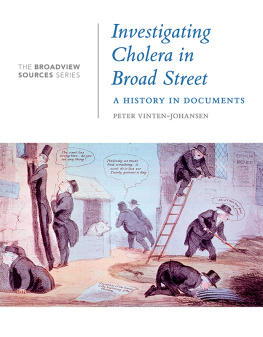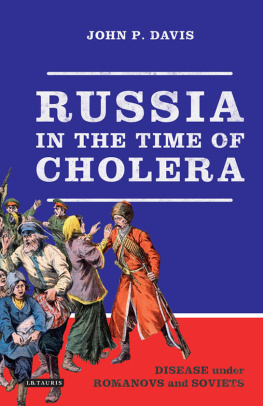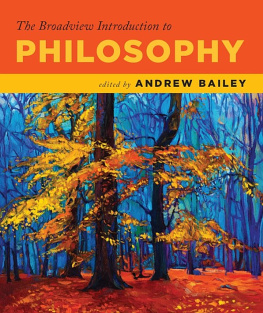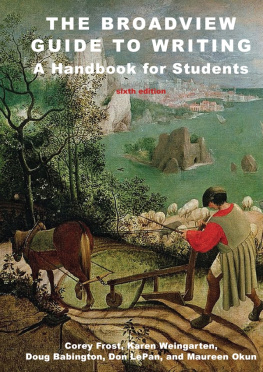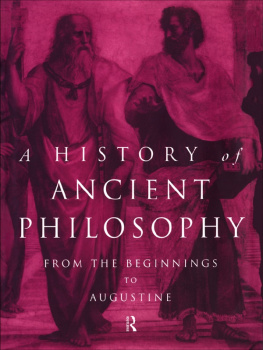THE BROADVIEW SOURCES SERIES
Investigating Cholera in Broad Street
A HISTORY IN DOCUMENTS
edited by PETER VINTEN-JOHANSEN
B ROADVIEW PRESS www.broadviewpress.com
Peterborough, Ontario, Canada
Founded in 1985, Broadview Press remains a wholly independent publishing house. Broadviews focus is on academic publishing; our titles are accessible to university and college students as well as scholars and general readers. With 800 titles in print, Broadview has become a leading international publisher in the humanities, with world-wide distribution. Broadview is committed to environmentally responsible publishing and fair business practices.
2020 Peter Vinten-Johansen
All rights reserved. No part of this book may be reproduced, kept in an information storage and retrieval system, or transmitted in any form or by any means, electronic or mechanical, including photocopying, recording, or otherwise, except as expressly permitted by the applicable copyright laws or through written permission from the publisher.
Library and Archives Canada Cataloguing in Publication
Title: Investigating cholera in Broad Street : a history in documents / edited by Peter Vinten-Johansen.
Names: Vinten-Johansen, Peter, editor.
Series: Broadview sources series.
Description: Series statement: The Broadview sources series | Includes bibliographical references and index.
Identifiers: Canadiana (print) 20200178083 | Canadiana (ebook) 20200178148 | ISBN 9781554813940 (softcover) | ISBN 9781770487345 (PDF) | ISBN 9781460406908 (HTML)
Subjects: LCSH: CholeraEnglandLondonHistory19th centurySources.
Classification: LCC RC133.G6 I58 2020 | DDC 614.5/14dc23
Broadview Press handles its own distribution in North America:
PO Box 1243, Peterborough, Ontario K9J 7H5, Canada
555 Riverwalk Parkway, Tonawanda, NY 14150, USA
Tel: (705) 743-8990; Fax: (705) 743-8353
email:
For all territories outside of North America, distribution is handled by Eurospan Group.
Broadview Press acknowledges the financial support of the Government of Canada for our publishing activities.
Copy-edited by Juliet Sutcliffe
Book design by Em Dash Design
PRINTED IN CANADA
To Betty, and in memory of David Zuck
PREFACE
Mid-October 2010
Mirebalais, Haiti
S ome called him the town fool. He talked to himself, heard voices that no one else could, was fearful and paranoid. Every day, the twenty-eight-year-old man wandered to the Rivire la Them, where he would bathe, drink his fill, and amble home. He had repeated the same routine day after day, year after yearuntil 12 October 2010. That Tuesday, however, he rushed home shortly after the onset of diarrhea. The diarrhea became more profuse, more frequent, and eventually watery. He lived in such misery only twenty-four hours. His family arranged a funeral service. Two people involved in preparing the body for a wake came down with severe diarrhea a couple days later, but both recovered.
Shortly thereafter, several residents of a nearby village developed watery diarrhea and went to the community hospital in Mirebalais. When more cases of acute diarrhea appeared, hospital staff requested assistance from the Haitian Ministry of Health and Population. Epidemiologists from Haiti and France immediately began looking for the handle on this Broad Street pump.
I. THE BROAD STREET PUMP EPISODE, 1854
Wheres the handle on this Broad Street pump?an expression sometimes used by public health workers when investigating an epidemic disease outbreakis derived from an event during the 1854 cholera epidemic in St. James, Westminster (West London), England. Nearly four hundred people died of cholera in five days within a circular area centered where Broadwick Street today intersects Lexington Street. Local authorities were flummoxed. They whitewashed streets with lime, deodorized cesspools, and covered sewer grates. They urged healthy people to flee, if at all possible, until fresh westerly winds could dissipate this local intensification of the current, widespread metropolitan cholera epidemic.
The Cholera Field
A circle, 400 yards in diameter, with center at the intersection of Broadwick and Lexington Streets (formerly Broad and Cambridge Streets).
(London Map [detail], from Collins London Streetfinder. HarperCollins UK, 2001. Reprinted with permission.)
John Snow, a physician, received a detailed account on Sunday evening, 3 September 1854the fourth day of the outbreak. He immediately suspected choleraic contamination of a common source of drinking water. He knew the affected neighborhoods as well as any London cabbie today. A popular pump in Broad Street (the former name of Broadwick Street) fit the bill. An hour or so before sunset, he left his house on Sackville Street and walked a quarter of a mile to the pump. He drew a small sample into a phial. Much to his surprise, Snow discerned none of the white, flocculent particles characteristic of sewage contamination. Next, he took samples from four nearby pumps. There was nothing alarming in any of them either. He sampled the Broad Street pump several times on Monday, and again Tuesday morning. The amount of visible organic impurity differed with each sample. So it was theoretically possible that choleraic discharges had seeped into the well several days earlier and caused the outbreak.
flocculent: Flaky.
Snow then walked to the General Register Office where he copied addresses of all deaths from cholera and diarrhea in the cholera field registered the previous week. He returned to the outbreak area and began house-to-house inquiries into the drinking-water habits of those on his list who had died during the first three days of the outbreak. Thursday evening, Snow informed the sanitary committee in charge of the parish response to the outbreak that at least eighty per cent of the deceased had consumed water from the Broad Street pump. Although the outbreak was ebbing, the sanitary committee decided to have the pump handle removed the following morning.
What had happened? Three inspectors appointed by the General Board of Health commenced house-to-house inquiries into the sanitary state of the cholera field the same day the parish disabled the Broad Street pump. They documented all instances of excessive filth and other predisposing causes of epidemic disease. An engineer investigated complaints that noxious smells emitted by sewer grates had caused the outbreak. Henry Whitehead, a curate who had ministered victims throughout the ordeal, gathered additional information on deaths and recoveries in his religious parish and published his findings. Late in the fall of 1854, the St. James, Westminster vestry appointed a cholera inquiry committee (which soon added Snow and Whitehead to its membership) to undertake a comprehensive investigation.

